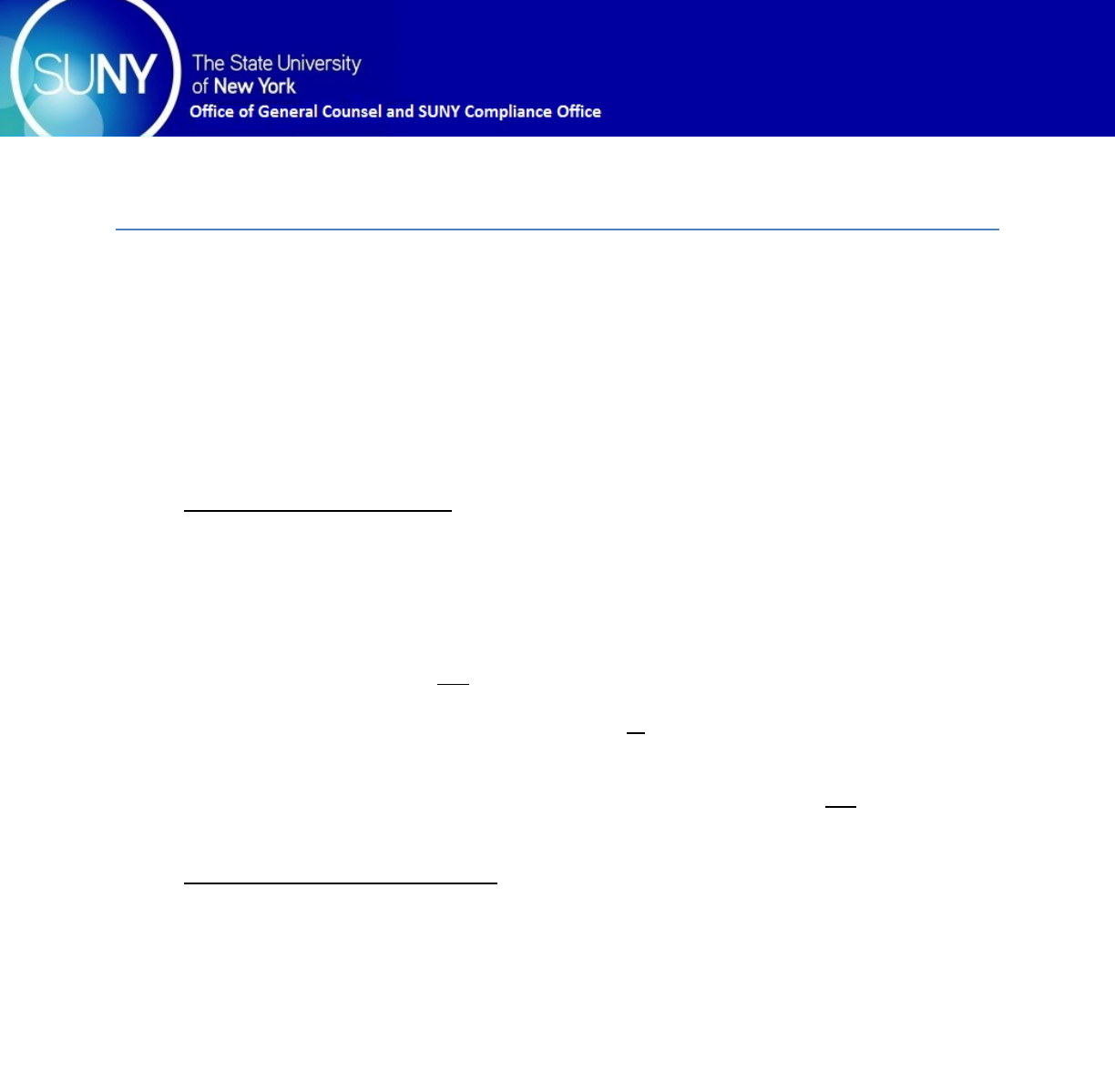
Child Protection Policy – Guidance
A. Introduction
The purpose of this guidance document is to the Child Protection Policy (the “Policy”) and its applicability in
various circumstances. The date at the bottom of the document will show when this guidance was last
updated.
B. Definitions
1. Custody, Control, Supervision
“Custody, control and supervision” means that a parent or legal guardian has placed the child in the care of
the University, University-affiliated organization or third party for a duration of time and for a specific
covered activity. The University, its affiliate, or third party is exercising its own authority to guide, manage
and supervise the child, in the place of the parent or legal guardian.
Note that the phrase “custody, control and supervision” is used in the conjunctive where it first appears in
Policy Section C, Definitions, Covered Activity. In the same section, under the definition of Covered Persons,
the phrase is constructed in the disjunctive: “custody, control or supervision.” These alternate constructs
acknowledge variations in the duties of Covered Persons. For example, one Covered Person may supervise
the Covered Activity, while another may be called in simply to take attendance. The first is supervising the
children; the second is controlling the children. Nonetheless, overall “custody, control and supervision” is
vested with the University, its affiliate, or the third party.
2. University-Affiliated Organizations
For purposes of the Policy, there exist only four (4) University-Affiliated Organizations:
(1) The Research Foundation;
(2) The Campus Foundation;
(3) The Campus Alumni Association; and
(4) The Campus Auxiliary Services Corporation.
a. University-affiliated organizations are not treated as third parties under the Policy. Policy Section I,
Third Party Use of University Facilities, is not applicable to University-affiliated organizations.
b. Policy Section G, Campus Responsibilities, requires each campus, System Administration and
University –affiliated organization to develop procedures to implement the Policy. In a practical
sense, the four University-affiliated organizations can only develop procedures in cooperation with
________________________________________________________________________________________
July 15, 2015 Child Protection Policy – Guidance
Page 1

their campuses, because the campus and its affiliates must coordinate on such matters as training,
investigation, reporting, and designation of a Responsible University Official.
c. When a University-affiliated organization sponsors a Covered Activity on campus, it must appoint a
Responsible University Official unless, in coordination with the campus as discussed above in
subpart (b), the Responsible University Official designated by the campus is responsible for all
Covered Activities conducted on campus.
d. The Policy does not cover University-affiliated on-campus child care centers, regardless of whether
they are operated by the University or by a separate corporate entity.
e. Student organizations, despite their ties to the University by charter, faculty advisors or budget, are
not University-affiliated organizations under the Policy definition unless they are so designated by
the Chancellor or the campus President. Absent such designation, there is no obligation to treat
student groups as University-affiliated organizations.
Designating a student group as an affiliate is event-based, not permanent. Designating a student
group as an affiliate for an event means that the event they conduct with children becomes a
Covered Activity. This triggers the provisions of Policy Section G, Campus Responsibilities and
makes those provisions applicable to the student group. Additionally, such designation makes
student group members Covered Persons, which triggers the Responsible University Official to take
the steps outlined under Policy Section F, Responsible University Official, with respect to them.
The decision to designate student groups as University-affiliated organizations rests with the
campus, but the Policy does not require such designation. Designation will create additional
responsibilities for the campus, specifically, the requirements of Policy Sections F & G described in
the preceding paragraph. The campus may also be exposed to liability for the actions of student
groups by virtue of their designation as a University-affiliated organization. Non-affiliated student
groups engaged in activities with children occurring off-campus are not subject to the Child
Protection Policy.
For non-affiliated student groups to engage in Covered Activities on campus, the Policy provides
only two options:
(1) The student group may run the Covered Activity as “permittees” who sign and abide by the
terms of a Revocable Permit; OR
(2) The student group may fit under the definition of “Covered Persons,” specifically, as an
“other person who is given permission to come onto the campus or to use University
facilities for Covered Activities.” (Policy Section C, Covered Person (iv).) Other persons
given permission to come onto the campus or to use campus facilities for Covered Activities
are guests/invitees of the University. They are not permittees required to execute a
Revocable Permit.
Under Option 2 above, the Policy requires the following:
• The Responsible University Official must obtain an Acknowledgement Form from the student
group prior to commencement of the Covered Activity. (Policy Section F. 3.) Exhibit D to the
Model Revocable Permit may be adapted by the campus for such use.
________________________________________________________________________________________
July 15, 2015 Child Protection Policy – Guidance
Page 2

• In signing the Acknowledgement, the student group acknowledges that Sex Offender Registry
searches have been conducted in accordance with the Policy for each of their Covered Persons.
Should the campus lack confidence in a student group’s ability to comply with this requirement,
it may run the Sex Offender Registry checks and revise the Acknowledgement Form
accordingly.
• The campus must communicate the requirements of the Policy to each Covered Person. (Policy
Section G. 3).
3. Child
The Policy definition of “child” is:
An individual under age of seventeen years, who is participating in a Covered Activity. The term
‘child’ shall not include a matriculated student of the University or a person accepted for
matriculation.
The term “matriculate” as used in the Policy takes its ordinary dictionary definition: “to enroll as a member
of a body and especially of a college or University.” For purposes of the Policy, a student is “matriculated”
if they are accepted by the University as a student into an actual college course listed in the college catalog.
Any campus definition of “matriculation” that may differ is not applicable for purposes of the Policy.
4. Covered Activities
An activity is only “covered” if it meets the two-part Policy definition:
(a) it is sponsored or approved by the University, University-affiliated organization or conducted by a
vendor, licensee or permittee for which a license or permit for use of University facilities has been
approved, occurring on or off campus; and
(b) for the duration of the activity, custody, control and supervision of children is vested in the
University, University-affiliated organization or the approved vendor, licensee or permittee.
In determining whether an event is a Covered Activity, it is useful to use a “decision-tree” approach,
starting with whether the participants are “children” under the Policy definition. If YES, proceed to Part 1
of the Covered Activity definition. If Part 1 is satisfied, proceed to Part 2.
For activities that do not meet the definition of Covered Activity, the Policy does not apply. For example:
1. Incidental visits where custody, control and supervision is not vested might include:
o events that are open to the general public, such as concerts, athletic events, exhibitions and
seasonal events such as winter carnivals and Halloween parties.
o children accompanying a visitor to campus (e.g., accompanying a sibling on a recruiting visit)
o “field trips” where children are brought onto campus by a school or other organization and the
representatives of those schools or organization remain with the children throughout the trip and
responsible for the custody, control and supervision.
________________________________________________________________________________________
July 15, 2015 Child Protection Policy – Guidance
Page 3

2. Unless Greek organizations or student government clubs or organizations are designated by the
Chancellor or the campus President as University-affiliated organizations for an event, the events they
sponsor are not “Covered Activities.” because the events do not meet the 2-part definition of Covered
Activity. See, Policy Section C, Definitions. See also, Guidance Section B (2)(e), University-Affiliated
Organizations.
3. High school students who are under 17 years of age commonly take college courses. If the student is
“matriculated,” i.e., has been accepted by the University as a student in an actual college course listed
in the college catalog, the courses taken do not become Covered Activities by virtue of the fact that an
individual under age 17 is in attendance. See, Policy Section C, Definitions. See also, Guidance Section
B, Definitions, 3, Child.
4. Internships, student teaching assignments, affiliations, and volunteer work conducted off-campus by
students or faculty are generally not Covered Activities, because the responsibility for custody, control
and supervision of children is not vested in the University, University-affiliated organizations or
approved vendor, licensee or permittee. If an on-campus event is co-sponsored with an organization
such as the 4-H or the Boy/Girl Scouts, a determination must be made on a case-by-case basis as to
which entity has responsibility for the custody, control and supervision of children. (See, Guidance
Section H, Co-Sponsored Activities.)
Activities that may meet the definition of Covered Activity include:
1. Research programs conducted on campus may involve student and faculty contact with families and
children. Whether these are Covered Activities that trigger the Policy requirements must be
determined on a case-by-case basis. For example, if parents are present, they retain responsibility for
custody, control, and supervision of their children and such responsibility is not vested in the
University, University-affiliated organizations, or approved vendor, licensee or permittee.
2. On-campus activities involving children that are organized by faculty members may or may not be
Covered Activities. A determination must be made on a case-by-case basis as to whether the
University, University-affiliated organizations, or approved vendor, licensee or permittee is responsible
for the custody, control and supervision of the participating children. Faculty members acting on
campus in their individual capacities should be governed by the Model Revocable Permit attached to
the Policy.
3. Some campuses hold Permits to operate Children’s Camps from the New York State Department of
Health. These Children’s Camps are Covered Activities subject to the provisions of the Child Protection
Policy because they meet the 2-part definition of Covered Activities. In other cases, a third party holds
a Camp Operator Permit from the New York State Department of Health and operates the camp using
University facilities. In such event, the Camp Operator should use University facilities pursuant to the
Model Revocable Permit attached to the Policy.
4. Children under age 17 who are not matriculated or accepted for matriculation sometimes volunteer at
the campuses. An example is a non-matriculant under age 17 who volunteers to work in a laboratory.
The campus may enter the child into its Human Resources systems for insurance coverage purposes.
Departments and supervisors are informed of the rules and regulations from the New York State
Department of Labor regarding employment of minors and the regulations are observed.
(http://www.labor.ny.gov/workerprotection/laborstandards/workprot/minors.shtm
). In this scenario,
the children are under the custody, control and supervision of the University and the program they are
________________________________________________________________________________________
July 15, 2015 Child Protection Policy – Guidance
Page 4

working in is sponsored or approved by the University. Therefore, both prongs of the Covered Activity
test have been met, making this volunteerism a “Covered Activity.” A Covered Person must be
appointed for their custody, control and supervision.
5. Covered Persons
Children under 17 cannot be “Covered Persons.” (For example, a 16-year-old volunteer assisting with a
summer camp.) Covered persons are defined as “persons who are responsible for the custody, control or
supervision of children participating in a Covered Activity.” As such, they cannot simultaneously be
“children,” defined as “an individual under the age of seventeen years, who is participating in a Covered
Activity.” The only children under 17 years of age who could meet the definition of “Covered Person” are
those who are matriculated students of the university or who have been accepted for matriculation.
Parents who volunteer to participate in Covered Activities are “category (iii)” Covered Persons as defined in
the policy and should be treated the same as “category (i) and (ii) Covered Persons.
C. Responsible University Official
1. A Responsible University Official (RUO) must be designated for each Covered Activity. RUOs may or
may not be present at the Covered Activity. Where Covered Persons are present at the Covered
Activity, the RUO need not be present, so long as they are available (i.e. responsible) to the Covered
Persons. For example, if designated RUO is away on vacation or medical leave, or absent in such a way
that s/he is not available to the Covered Persons handling the Covered Activity, an alternate RUO must
be designated for the Covered Activity.
2. The UUP contract provides for employees required to be “on call” to be paid an hourly wage for the on-
call period. Campuses may wish to consider this when appointing Responsible University Officials.
D. Being Alone With Children
The Policy aims to protect children from 1-on-1 contact with adults, including Covered Persons, through
which children may be at risk of physical or sexual abuse. Exceptions to the 1-on-1 provisions of the Policy
should therefore be applied only with thorough and cautious consideration.
1. Campuses may create exceptions to the 1-on-1 prohibition in situations where the pedagogical or
health-related nature of the activity logically involves only two participants, such as an
instructor/treating professional and a student/patient. Examples of these activities include, but are not
limited to, tutoring, music lessons, speech therapy, and medical, dental, or optical services. Parental
release forms are suggested for such exceptions, but even excepted activities should generally be
observable and interruptible by other adults, as appropriate for the activity. Campuses should also
consider whether such activities can be conducted in a public setting or in a space that is easily
viewable and accessible by others.
2. Transportation, bussing, locker rooms, shower rooms and rest rooms will require additional attendants
to ensure that no child is alone with an adult.
3. In a true emergency, 1-on-1 contact is permissible.
________________________________________________________________________________________
July 15, 2015 Child Protection Policy – Guidance
Page 5

E. Sex Offender Registry Searches
The Policy sets out the requirements for sex offender registry checks and places the responsibility for
conducting them upon the University, University-affiliated organizations and approved vendors, licensees
and permittees. See, Policy Section G, Campus Responsibilities and Model Revocable Permit ¶18.
Currently, SUNY has no system-wide policy on conducting background checks, but University Police conduct
criminal background checks through the New York Department of Criminal Justice Services (DCJS) if
required by state or federal laws or regulations for a particular job classification. University Police can
obtain criminal background information from DCJS only if it is authorized by statute or if the information is
sought in connection with a criminal investigation. For any other purpose, DCJS cannot provide criminal
background information unless the subject of the investigation gives written consent. 9 NYCRR § 6050.1(a).
In their local procedures, campuses may elect to obtain consent, but the sex offender registry websites are
available to the public. A refusal to give consent would disqualify an individual from participating in a
Covered Activity.
1. A Registry Search must be performed on all Covered Persons using both New York and national
registries. A Registry Search is not a background check. A Registry Search is targeted to identifying
convicted sex offenders.
2. Vendors, licensees, permittees or other persons given permission to come onto campus or to use
University facilities for Covered Activities are responsible to conduct sex offender registry checks on
their employees, agents and volunteers participating in the Covered Activity. The policy does not
require that the sex offender registry search results on these Covered Persons be submitted to the
University.
3. The campus and University affiliated organizations must promulgate procedures to identify: (1) staff to
conduct the Registry Search; (2) staff that shall have access to the resulting information; and (3)
recordkeeping procedures.
4. Sex Offender Registry searches must be conducted no sooner than 90 days in advance of an event, so
the information will be current. Sex Offender Registry searches are timed to the Covered Activity; not
to a semester or other periodic or episodic time interval. Covered Activities must not proceed without
completion of Sex Offender Registry Searches as required by the Policy.
5. When a Sex Offender Registry Search identifies an individual as a convicted sex offender, that individual
cannot participate or be involved in any way with a Covered Activity. A positive result may raise an
employee relations issue and that department should be consulted before further action is taken. The
HR issues that may accompany a positive result are outside the scope of the Child Protection Policy and
should be handled by campus HR offices in accordance with their policies.
6. The National and State Sex Offender Registries cannot identify individuals who have been convicted of
sex abuse crimes in other countries. The policy contains no requirement that campuses attempt to
check similar databases in other countries. Campuses should take this into consideration in exercising
their discretion to assign Covered Persons to Covered Activities, and in granting the use of their
facilities to third party permittees.
7. The Child Protection Policy requires that search results be kept for six years after the Covered Person
has separated from the University or University-affiliated organization. Although the statute of
________________________________________________________________________________________
July 15, 2015 Child Protection Policy – Guidance
Page 6

limitations for civil cases of sexual abuse is longer, there is no reason to extend the retention period for
Sex Offender Registry search results. However, SUNY Policy No. 6609 (records retention schedules)
require Athletics records to be maintained for “a minimum of 7 years.” Campuses might choose to
consider the records of a sports-related Covered Activity to be “Athletics Records,” and can retain them
for as long as they choose, since the Retention Schedule cites a minimum, but no maximum, retention
period for Athletics Records. Similarly, the retention period for SUNY Public Safety Records (certain
police records, investigation reports, etc.) is, in some cases, “permanent.” Any reported incident of
sexual abuse that arose during a Covered Event would have a permanent record based on that
retention schedule.
F. Training
1. Training Frequency: Campuses must train their Covered Persons by May 15, 2015 and biennially (every
two years) thereafter. See, Policy Section G. 4. No individual may participate in a Covered Activity as a
Covered Person without first having received training.
2. SUNY System Administration has developed a university-wide training on the Policy. Campuses may be
responsible for confirming and recording attendance of Covered Persons who are employees,
volunteers, students, or agents of the campus or a University-affiliated organization.
3. The University has no responsibility to train third-party users of University facilities. See, Policy Section
G, Campus Responsibilities, (4). University employees may volunteer or work for external organizations
that are also third-party users of University facilities. Technically, the University has no responsibility to
train such employees, because they are representatives of the third party permittee during the Covered
Activity. However, should this be a frequent occurrence, the best practice is to train such employees.
G. Identification of Covered Persons
1. All Covered Persons participating in Covered Activities should be identified by photo ID affixed to a
lanyard (for active sports an arm or wrist band may be appropriate). The ID should be event-specific, to
include the event name, date(s) as well as the Covered Person’s name and photo. Shirts, uniforms and
such attire, and non-photo IDs may be duplicated or misappropriated.
2. Event specific identification means that a single identification for a Covered Person participating in
multiple Covered Activities is not sufficient (for example: “Summer Athletic Programs”) At larger
campuses, Covered Persons may not know each other until they are introduced at the Covered Activity.
Both the Covered Persons and the participating children need to be able to rely on the fact that a
person with an ID is authorized to participate in their specific activity. Also, ID badges are not likely to
have the security of a “key card” that can be deactivated if the employee is terminated.
H. Third Party Use of University Facilities
Third parties (vendors, licensees, permittees, referred to collectively as “Permittees”) given permission to
use University facilities for Covered Activities must do so pursuant to the Model Revocable Permit for
Covered Activities appended to the Policy. Private events, such as weddings and private parties are
considered Third Party use of University Facilities and are subject to the Policy only if children are present.
The Model Revocable Permit attached to the Child Protection Policy is for use with Covered Activities. For
________________________________________________________________________________________
July 15, 2015 Child Protection Policy – Guidance
Page 7

all other use of University facilities when no children are present, the standard SUNY Revocable Permit is
applicable.
1. Permittees must be given copies of the SUNY Child Protection Policy (No. 6505) and the SUNY Policy on
Mandatory Reporting and Prevention of Child Sexual Abuse (No. 6504). Permittees must provide a
written acknowledgement to the campus of their receipt of the policies on Exhibit D to the Model
Revocable Permit. Campuses must provide, at minimum, SUNY Policy Nos. 6504 and 6505. Campuses
may also elect to provide their local policies or procedures. In such event, the campus should revise
Exhibit D to reflect its inclusion of its local policies.
2. Permittees are responsible for conducting Sex Offender Registry searches for all of their employees,
volunteers, and agents, which would include all subcontractors, who come onto campus or use
University facilities for Covered Activities pursuant to the Model Revocable Permit. By signing the
Revocable Permit, Permittees acknowledge that Sex Offender Registry searches have been conducted,
and that they have been conducted no sooner than 90 days before the scheduled event. The campus is
not required to review, record or file the third party’s search results.
3. When the campus determines in its discretion that the Permittee’s event is substantial (e.g. an
overnight camp), of substantial duration (e.g. one week), or involves large numbers of children, the
campus may require the Permittee to obtain Sexual Molestation Insurance (“SMI”). The specific policy
language is:
For those instances in which a campus believes that the activity is so long or
substantial and that the obtaining of such insurance will not unduly preclude
beneficial use of the campus’ facilities, the campus should require [SMI].
SMI is generally excluded from Commercial General Liability (“CGL”) policies and must be purchased
separately. As a state educational corporation, SUNY is not authorized to provide guidance to third
parties regarding their purchase of insurance. We can, however, recommend that they contact their
insurance broker or insurance agent for professional advice on coverage, costs, and application
requirements.
The SUNY policy revocable permit requires “…General Liability insurance two million dollars
($2,000,000) each occurrence and two million dollars ($2,000,000) in the aggregate..” These limits can
be provided through a combination of primary and excess/umbrella liability policies. (See, Council of
Contracting Agencies’ Procedure Manual for Insurance Requirements in Agreements, Ch. 3, p.
27. Adopted by the NYS Procurement Council August 2011.)
The following summary explains the 6-month minimum effective period for a “claims made” general
liability policy.
o Liability insurance policies may be written as “Claims Occurrence” policies or as “Claims Made”
policies.
o An “occurrence” policy provides coverage for claims arising out of an event that occurs during the
period the policy is in effect.
Example: A third party Permittee uses University facilities for a Covered Activity for one
week in June 2015. The Permittee purchases Sexual Molestation insurance for that week
and the policy is an “occurrence” policy. If 20 years later, a child who attended the event
files a claim for damages arising from sexual molestation that occurred during that week
________________________________________________________________________________________
July 15, 2015 Child Protection Policy – Guidance
Page 8

in June 2015, the insurance company is responsible for its payment, up to the limits of the
policy, because coverage is based on when the events giving rise to the claim occurred.
o A “claims made” policy provides coverage for claims that are made during the time the policy is in
effect.
Example: A third party Permittee uses University facilities for a Covered Activity for one
week in June 2015. The Permittee purchases a “claims made” Sexual Molestation
insurance for that week. For the week that the policy is in effect, the insurance company
is responsible for payment of any sexual molestation claim made against the insured
Permittee, whether it is made by a child participating that week in June, or whether it is
made by someone who claims they were sexually molested by the permittee 20 years
ago.
o The Child Protection Policy requires that Sexual Molestation insurance purchased on a “claims
made” policy have a minimum 6 months of what is called “tail coverage.” Under the primary
policy, the period for allowable claims is only 1 week in June, but the tail coverage extends that
deadline for 6 additional months.
o The Revocable Permit accompanying the Child Protection Policy affords the campuses discretion
on whether to require Sexual Molestation insurance from Permittees. It must follow then, that
the campuses have discretion to require the coverage be provided by “occurrence” policies or
“claims made” policies. Campuses also have the discretion to require a longer tail coverage if on
claims made policies.
4. By signing the Revocable Permit, Permittees acknowledge that they will adhere to the American Camp
Association standards for minimum staff-to-child ratios and will provide transportation for minors to
and from the campus in accordance with the provisions of the Revocable Permit, which requires that in
addition to the driver of the vehicle, there must be at least one other staff member in the vehicle at all
times.
5. A Permittee holding a Camp Operator Permit from the New York State Department of Health is not
exempt from the provisions of the Model Revocable Permit. A children’s camp operated by a third
party Permittee using University facilities must adhere to the New York State Department of Health
standards for licensed camps and to the University’s standards as enunciated in the Child Protection
Policy and the Model Revocable Permit.
6. The American Camp Association (ACA) standards cited in the Revocable Permit are applicable ONLY to
the Covered Activities of approved vendors, licensees and permittees. ACA standards do not apply to
Covered Activities for which the custody, control, and supervision of children is vested in the University
or University-affiliated organizations. Campuses may, at their discretion, choose to use ACA standards
for their own Covered Activities.
I. Co-Sponsored Activities
Outside organizations and educational institutions may co-sponsor Covered Activities with the University.
In a co-sponsored event, the University and the co-sponsor have shared responsibility for custody, control
and supervision of children. An example is the Model Organization of American States Conference, which is
co-sponsored by a campus program and area schools. Teachers from the area schools chaperone the event
________________________________________________________________________________________
July 15, 2015 Child Protection Policy – Guidance
Page 9

and stay in the college dormitories with students. The College hires its students as hall monitors. College
students from the campus program serve as mentors.
In this example, the Model Organization of American States Conference and the teachers from area schools
are guests/invitees of the University. They fall within the definition of Covered Person (iv): “a vendor,
licensee, permittee or other person, who is given permission to come onto the campus or to use
University facilities for Covered Activities.” See, Section C, Covered Person (iv). These guests/invitees have
permission to come onto campus to participate in a Covered Activity, but they are not permittees required
to execute a Revocable Permit.
Under a co-sponsored arrangement:
• The Responsible University Official must obtain Acknowledgement Forms from these Covered
Persons (institutions) prior to commencement of the Covered Activity. (Policy Section F. 3.) Exhibit
D to the Model Revocable Permit may be adapted by the campus for such use.
• In signing the Acknowledgement, the teachers’ institutions and the Model Organization of
American States Conference acknowledge that Sex Offender Registry searches have been
conducted in accordance with the Policy for each of their Covered Persons.
• The campus must communicate the requirements of the Policy to each Covered Person. (Policy
Section G. 3).
________________________________________________________________________________________
July 15, 2015 Child Protection Policy – Guidance
Page 10
